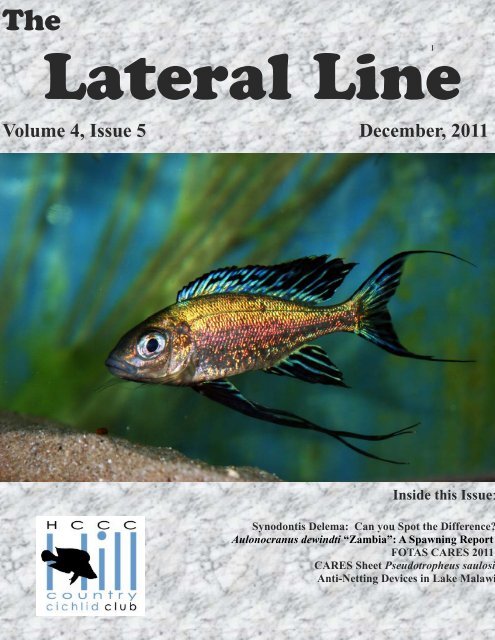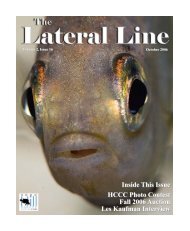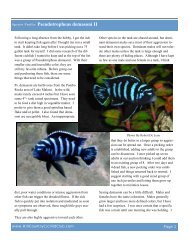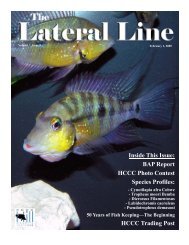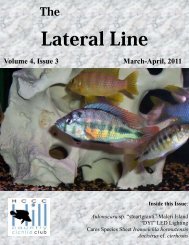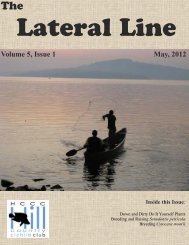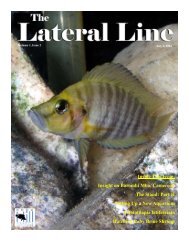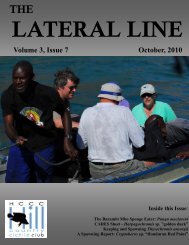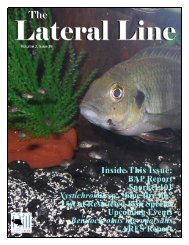Lateral Line December 2011 - Hill Country Cichlid Club
Lateral Line December 2011 - Hill Country Cichlid Club
Lateral Line December 2011 - Hill Country Cichlid Club
You also want an ePaper? Increase the reach of your titles
YUMPU automatically turns print PDFs into web optimized ePapers that Google loves.
The<br />
1<br />
<strong>Lateral</strong> <strong>Line</strong><br />
Volume 4, Issue 5 <strong>December</strong>, <strong>2011</strong><br />
Inside this Issue:<br />
Synodontis Delema: Can you Spot the Difference?<br />
Aulonocranus dewindti “Zambia”: A Spawning Report<br />
FOTAS CARES <strong>2011</strong><br />
CARES Sheet Pseudotropheus saulosi<br />
Anti-Netting Devices in Lake Malawi
2<br />
The HCCC is a proud member of<br />
the Federation of Texas<br />
Aquarium Societies.<br />
The HCCC is a proud member of<br />
the Federation<br />
of American Aquarium<br />
Societies.<br />
Contents:<br />
Can You Spot the Difference? 3<br />
- David Ayres<br />
Aulonocranus dewindti “Zambia”: A Spawning Report 6<br />
- Benjamin L. Smith<br />
FOTAS CARES <strong>2011</strong> 10<br />
- Greg Steeves<br />
Pseudotropheus saulosi, CARES Sheet 32<br />
Folks …it’s payback time 35<br />
- Ad Konings<br />
What a convention! FOTAS CARES was a<br />
huge success. I can only hope that another<br />
CARES club will grab the reigns and host<br />
the second CARES convention.<br />
It was good to see old friends again. Especially<br />
JB. I’m looking forward to his moving<br />
back to Texas. There were so many<br />
good memories made at the convention<br />
filled with incredible speakers and presentations,<br />
zany events and camaraderie with fish<br />
friends. I have included some photos and a<br />
short write up of the affair in this issue.<br />
Speaking of content in this issue, I am extremely<br />
pleased to share with everyone an<br />
article by David Ayres on a subject that has<br />
touched almost all of us...differentiating<br />
some of those Tanganyikan catfish that we<br />
all love so much. Thanks David for letting<br />
us reprint your article.<br />
Benjamin strikes again with a report on his<br />
spawning of Aulonocranus dewindti. I have<br />
always admired these fish but have never<br />
had the courage to try them.<br />
At FOTAS CARES, Ad Konings spoke on<br />
the situation with native fish in Lake Malawi.<br />
Many people, including myself, were<br />
shocked that old favorites such as Pseudotropheus<br />
saulosi and Ps. socolofi are becoming<br />
rare in the great African lake. These<br />
two species are now unfortunately, added to<br />
the CARES list so I have included a CARES<br />
sheet on the first Malawian addition, Ps saulosi.<br />
Ad tops the issue off with an article<br />
born of the conference. He discusses the<br />
Anti Netting Devices deployed at Malawi<br />
National Park and his plans to ensure that<br />
some threatened fish do not end up like<br />
their Lake Victoria cousins.<br />
<strong>2011</strong> was largely a planning year for the<br />
HCCC. We spent most of our energy on<br />
preparing for FOTAS CARES. 2012 will<br />
see some exciting restructuring and getting<br />
back to having fun. We end this year with<br />
our annual Christmas Party at Dan and<br />
Elaine’s in Seguin. See everyone there!
3<br />
Can You Spot the Difference?<br />
- David Ayres<br />
Synodontis lucipinnis is a charming Tanganyikan catfish common n the cichlid aquarium.<br />
This species along with others has been the source of much confusion over identification.<br />
Is it Synodontis petricola or Synodontis<br />
lucipinnis? For some time now a debate has<br />
been ongoing concerning the identity of<br />
these two fish. It seems to be fashionable<br />
nowadays that whenever a photograph is<br />
posted on the web labeled as S. petricola to<br />
respond by saying , "Oh no , that's S. lucipinnis"<br />
Most respondents no not whereof they<br />
speak , most are not even keeping Synodontis.<br />
At next month's meeting (Oct) our guest<br />
speaker will be Jeremy Wright who, along<br />
with co-author Lawrence M. Page, published<br />
a paper back in <strong>December</strong> 2006 that recognized<br />
eleven species of Synodontis from<br />
Lake Tanganyika . Included among those<br />
eleven species were three newly described<br />
species which are, S. ilebrevis, S. grandiops<br />
and the subject of this article S. lucipinnis.<br />
Jeremy gave a talk at the 2010 All Aquarium<br />
Catfish Convention in Fairfax Virginia,<br />
which, as far as I know, was where a significant<br />
number of North American hobbyists<br />
were first introduced to Synodontis lucipinnis.<br />
And so began the confusion within the<br />
organized hobby of differentiating between<br />
the newly described S. lucipinnis and a fish<br />
that everyone in the hobby knew as S. petricola,<br />
two fish that are remarkably similar in<br />
outward appearances.<br />
So what do we know about the two fish in<br />
question?<br />
Location: Well both species are endemic to<br />
Lake Tanganyika and both inhabit the rocky<br />
coastal areas. The "known distribution<br />
maps" however, do reveal differences in<br />
where populations occur . The type locality<br />
for S. lucipinnis is at the southern end of the<br />
lake from an area known as Musende Rocks<br />
(Mpulungu , Zambia.) This is the only place
This is the only place on the map that specimens<br />
of S. lucipinnis appear to be found. On<br />
the other hand the type locality for S. petricola<br />
is marked at the northwestern most end<br />
of the lake in the Democratic Republic of<br />
Congo some four hundred and fifty miles<br />
distant. Location points for S. petricola are<br />
shown at both the northern and southern<br />
ends of the lake with a marked absence in<br />
the central portions of the lake. I would<br />
think , but I<br />
d o n ' t<br />
know , that<br />
the only<br />
reason the<br />
central part<br />
of the lake<br />
shows an<br />
absence of<br />
populations<br />
of S. petricola<br />
is because<br />
nobody<br />
has<br />
collected<br />
there. So if<br />
you went to<br />
Musende<br />
Rocks in the south and collected there you<br />
would have S. lucipinnis and anywhere else<br />
in the lake you would have S, petricola............or<br />
would you? It seems farfetched<br />
to me to believe that whilst S. petricola<br />
probably has a lake-wide distribution,<br />
S. lucipinnis is restricted to one area at<br />
Musende Rocks.<br />
Size - does it matter? No, not when comparing<br />
holotypes. The holotype of S. lucipinnis<br />
measures 97mm total length and 78mm standard<br />
length. Compare that to the holotype of<br />
S. petricola which measures 98mm TL. and<br />
82mm SL., so there are no discernible differences<br />
there.<br />
Synodontis petricola or Synodontis lucipinnis?<br />
I studied both the morphometric and meristic<br />
counts for both S. lucipinnis and S. petricola<br />
and found absolutely no differences<br />
when taking into consideration the margins<br />
of error. The data shows that they could be<br />
the same fish.<br />
So what is it that makes these two fish, according<br />
to Wright and Page, different species<br />
? Answer, an axillary pore. That's all we<br />
need to know to tell the species apart. Synodontis<br />
petricola<br />
possesses<br />
an<br />
axillary<br />
por, Synodontis<br />
lucipinnis<br />
does not.<br />
When the<br />
next self<br />
proclaimed<br />
expert on<br />
the web<br />
holds forth<br />
ask him to<br />
point out<br />
the axillary<br />
pore or lack<br />
thereof.<br />
What is an axillary pore? The axillary pore<br />
is an opening or series of openings that is<br />
located between the base of the pectoral fin<br />
spines and the ventral margin of the humeral<br />
process. The purpose of the axillary pore is<br />
unknown in Mochokids but in other families<br />
of fish this structure has been shown to produce<br />
a mucosal secretion that contains toxic<br />
properties, a good defense system against all<br />
those nasty predatory cichlids.<br />
Before bringing this discussion to a close<br />
there is yet one more telling difference between<br />
S. petricola and S. lucipinnis. S. lucipinnis<br />
has light colored "windows" at the base<br />
of the black triangles in the fins (except the<br />
4
5<br />
One of the most sought after catfish from Lake Tanganyika, Synodontis granulosus.<br />
caudal) Having said that, I've looked at the<br />
photographs of the S. lucipinnis holotype<br />
and don't see it; but there again pickled<br />
specimens may not show this as clearly as<br />
live specimens , plus my<br />
eyesight is not exactly<br />
20-20 anymore. By the<br />
way the specific name<br />
lucipinnis is a combination<br />
of the Latin luci<br />
meaning bright or clear<br />
and the Latin pinnis,<br />
meaning fin, a reference<br />
to the light colored<br />
patches found at the<br />
base of the black triangles<br />
in the fins.<br />
Literature Cited.<br />
Wright, J.J. and L.M.<br />
Page. 2006. Taxonomic<br />
Revision Of Lake Tanganyikan<br />
Synodontis (Siluriformes: Mochokidae)<br />
Florida Mus. Nat. Hist. Bull. 46<br />
(4):99-154.<br />
Synodontis polli from the great African rift lake.
6<br />
Aulonocranus dewindti “Zambia”: A Spawning Report<br />
- Benjamin L. Smith<br />
A beautiful male Aulonocranus dewindti in the author’s aquarium.<br />
Aulonocranus dewindti is a cichlid of Lake<br />
Tanganyika found in the intermediate habitat<br />
1 . It fits the bill of both a sand sifter as<br />
well as a featherfin. Like most other<br />
featherfins, the males display lustrous colors<br />
when courting which they can turn off and<br />
on like a light. Unlike Cyathopharynx, they<br />
will tend to carry at least some color all of<br />
the time making it easy to differentiate the<br />
males from females in adult populations.<br />
The tips of the ventral fins have a hint of<br />
yellow, however they do not have the lappets<br />
that the Ophthalmotilapia ventralis and<br />
Ophthalmotilapia nasuta use as egg dummies.<br />
The variant I kept was from Dave's<br />
Rare Aquarium Fish and sported horizontal<br />
blue and yellow stripes. In Ad Konings'<br />
books, there are images of a fish from<br />
Mabilibili that appear to have a dark copper<br />
base with blue stripes and are quite stunning<br />
2 .<br />
The waters the fish hails from is like that of<br />
most of the lake in that it is alkaline and<br />
hard. The tap water at my home is the same<br />
so no adjustments are necessary other than<br />
dechlorinator. The temperatures range in the<br />
upper 70 O F in the lake and the tank temperatures<br />
at my home range from 73-75 O F.<br />
The slightly lower temperature doesn't seem<br />
to affect spawning frequency, though I have<br />
noted that in the tanks which I heat to 78 O F,<br />
the time for the fry to become free swimming<br />
drops from 3 weeks to 2 weeks.<br />
In the wild, the fish sifts sand searching for<br />
invertebrates. In my tank they were fed a<br />
staple diet flake. The fry were initially fed
7<br />
A male and holding female Aulonocranus dewindti in the aquarium.<br />
Hikari First Bites and subsequently crushed<br />
flake until ready for the regular flake.<br />
The fish were housed in a 55 gallon aquarium,<br />
initially as a pair, but later I added to<br />
make the group larger at 2 males and 3 females.<br />
I have kept six of these fish in the<br />
past with spawning occurring at regular intervals,<br />
however I never had a female hold<br />
an entire two weeks where I could safely<br />
strip her of the fry. The females usually spit<br />
just after seven days suggesting that the eggs<br />
were fertilized. In my 55 gallon tank, the<br />
older female held long enough only once<br />
and when I dipped the net in to get her, she<br />
spit her fry and her tank mates, Callochromis<br />
melanostigma, ate the fry immediately.<br />
Since that time, whenever I have a<br />
ten gallon tank available, I pull the female<br />
on the first or second day of holding and let<br />
her brood in solitary confinement. She<br />
seems to appreciate that. The dominant<br />
male continually harasses the females in the<br />
tank. I feel that this is the likely cause of the<br />
females not wanting to hold. The male also<br />
gave the newly added male, who at the time<br />
was half the size of the dominant male, a<br />
solid thrashing. I removed him and let him<br />
recuperate in a 125 gallon. He grew quickly<br />
and while he is now 3 inches, he is still<br />
about 1 inch shorter than the other, but is<br />
allowed to roam the tank and display a little<br />
color. Adult fish will ultimately reach 5-6<br />
inches in length 1 .<br />
I keep a great deal of rock-work in the tank<br />
for two reasons. The first is for hiding<br />
places for the females, though they never
8<br />
A dominant male Aulonocranus dewindti in normal dress.<br />
seem to use them. The second is due to the<br />
face that this fish prefers to build its nests<br />
against the rocks 1 . I have found that if I use<br />
rocks that are relatively tall, I can make a<br />
sort of u-shaped arena out of them and the<br />
male will always build his nest on this stage.<br />
I have read in several places that the males<br />
will decorate the edges of the nest with pebbles<br />
or shells. I provided both and they were<br />
both ignored or carried to the farthest<br />
reaches of the tank. My male likes a clean<br />
nest.<br />
These fish can start spawning early, as soon<br />
as 2 inches in overall length. In my experience,<br />
the fish will spawn again about six<br />
weeks after releasing fry. They will even do<br />
so is some pretty sad water conditions. I<br />
have been busy this year with work and water<br />
changes seem to be happening anywhere<br />
from once per month to once every two<br />
months. If it has been 1 month and I manage<br />
a water change, I invariably get a spawn<br />
within the next two days. Clutch sizes have<br />
ranged from 10 to 32 fry for me. They are<br />
not shy about spawning and I have even<br />
been able to record them on video. The eggs<br />
are whitish in color and about 1.5 mm in diameter.<br />
The females do not eat while holding<br />
but will come out at feeding time and<br />
give the food a long, hard look before going<br />
back to their safe spot in the tank.<br />
Initially, I kept this fish with Cyprichromis<br />
sp. “leptosoma jumbo” in a 125 gallon tank.<br />
I was not seeing any spawns from the Cyps<br />
and had already decided to move them when<br />
I actually witnessed the female Aulonocra-
9<br />
An adult Aulonocranus dewindti pair in the aquarium.<br />
nus hovering beneath the Cyps while they<br />
spawned one evening. She would dart up<br />
from the sand eat the eggs as they came out<br />
of the female Cyp before the Cyps could do<br />
anything about it. Now, they are kept with<br />
the aforementioned C. melanostigma. Both<br />
fish spawn successfully in the 55 gallon tank<br />
with 5 A. dewindti and 5 C. melanostigma.<br />
There is also a plecostomus whose L-<br />
number I have forgotten which is about 7<br />
inches long and keeps the tank absolutely<br />
spotless.<br />
I have really enjoyed keeping this fish. It is<br />
probably the easiest of the featherfins to<br />
keep, house, and spawn. It is not nervous<br />
(mine have not tried to jump out) and shows<br />
good color most of the time. They spawn<br />
young and do not requite a large amount of<br />
space; a 29-30 gallon tank will suffice for a<br />
group of 5-6 fish. In all, I would strongly<br />
recommend this fish to anyone looking for a<br />
sand sifter or featherfin.<br />
Bibliography<br />
Konings, Ad. Back to Nature Guide to Tanganyika<br />
<strong>Cichlid</strong>s. 2 nd Ed. <strong>Cichlid</strong> Press.<br />
2005.<br />
Konings, Ad. Tanganyika <strong>Cichlid</strong>s in their<br />
natural habitat. <strong>Cichlid</strong> Press. 1998.<br />
On the web<br />
www.hillcountrycichlidclub.com
10<br />
FOTAS CARES <strong>2011</strong><br />
- Greg Steeves<br />
The “Babes in the <strong>Cichlid</strong> Hobby” (Pam Chin, Caroline Estes and Pam Marsh) share a<br />
laugh with esteemed guests Melanie Stiassny and Paul V. Loiselle at FOTAS CARES.<br />
For those of you who did not have the opportunity<br />
to attend FOTAS CARES in San<br />
Antonio Texas November 4th-6th <strong>2011</strong>, I<br />
can only say that I am sorry for your loss.<br />
This was a fantastic convention! It was, by<br />
far, the largest undertaking our little club has<br />
ever attempted and will be spoken about for<br />
years to come.<br />
FOTAS (The Federation of Texas Aquarium<br />
Societies) holds conventions annually.<br />
These conventions rotate between member<br />
clubs. <strong>2011</strong> was the <strong>Hill</strong> <strong>Country</strong> <strong>Cichlid</strong><br />
<strong>Club</strong>’s turn. The HCCC’s involvement in<br />
CARES (www.carespreservation.com) is<br />
well established and we have been looking<br />
for a forum to showcase CARES for a long<br />
time. It seemed that FOTAS CARES,<br />
hosted by the <strong>Hill</strong> <strong>Country</strong> <strong>Cichlid</strong> <strong>Club</strong> was<br />
natural! The planning began.<br />
On the counsel of both Claudia Dickinson<br />
and Anton Lamboj, a tentative speaker<br />
lineup was constructed. The original program<br />
had seven names including Kathy England,<br />
a Texan legend in the hobby, Anton<br />
Lamboj, esteemed ichthyologist and honorary<br />
HCCC member, Lae Kaufman, most<br />
known in our circles for the work he has<br />
done in and around Lake Victoria, Melanie
11<br />
Kathy England spoke in pond plants and surprised everyone<br />
with a drawing for free plants after her lecture!<br />
Stiassny who’s recent work on the<br />
Congo River was the subject of a National<br />
Geographic special, Charles<br />
Jones, FOTAS president, fish expert<br />
working in almost every area of the<br />
industry, Paul V. Loiselle who is best<br />
described as “Fish god”, and Ad<br />
Konings who has been a friend to the<br />
HCCC since the beginning. As time<br />
drew on, Les and Anton were unfortunately<br />
not able to attend but the rest<br />
of the invited speakers were a go.<br />
Where to hold such a grand event?<br />
We selected the DoubleTree Inn near<br />
the San Antonio Airport. This facility<br />
had everything we could hope for. As<br />
it turned out, the weather was perfect<br />
and much of the time, attendees spent<br />
their leisure in the courtyard lounging<br />
beside the pool. This was the perfect<br />
location for our convention.<br />
The courtyard of The Doubletree Hotel
12<br />
After much, MUCH planning it was go time.<br />
I think everyone involved in the organization<br />
of this fiasco was quite nervous. Even<br />
though you may have planned for everything<br />
you could think of, the element of the unknown<br />
still looms ominously overhead.<br />
Friday morning was spent transporting<br />
equipment to the venue. Everyone really<br />
came together on this. By the time Choya<br />
and I had picked up the tanks for the kids<br />
contest (more on this to come) and arrived at<br />
the hotel, the construction crew had already<br />
not only built the racking for 100 20 gallon<br />
tanks, but were nearly done filling them.<br />
Dave Schumacher, Dan Schacht, Jim Smith,<br />
JB Edmundson and a host of others, were<br />
working as a well oiled machine! I was astounded<br />
at the work they had done is such a<br />
short period of time. David Fair had already<br />
positioned some of the vendors. It was all<br />
coming together.<br />
By mid afternoon attendees started wondering<br />
around. Even though registration did not<br />
open until 5pm, many people had arrived<br />
early to vacation in San Antonio, see the<br />
sights and go on fish store tours.<br />
Some of the first fish friends I encounters<br />
(besides HCCCer’s of course) were Claudia<br />
Dickinson, Lawrence Kent, David<br />
Boruchowitz and Ted Judy.<br />
Kory and Justin with<br />
Ad Konings and Paul Loiselle.<br />
Alan Rollings and David Fair.<br />
After Diane opened registration, it was time<br />
to get things going. What better way to kick<br />
it off than with some food. It was pizza<br />
time. As the banquet area was filled, ample<br />
pizzas were rolling out for the masses. After<br />
everyone had gotten their fill, it was time for<br />
the first event to begin. Melanie Stiassny<br />
was about to give a presentation of the fishes<br />
of the Congo River. Many people had made<br />
the trip to San Antonio just to hear her<br />
speak. Not only was her presentation excellent,<br />
but she was such a friendly lady taking<br />
the time to speak to all that were vying for<br />
her attention. What a wonderful person and<br />
I think we all left feeling like we had a rich<br />
individual interaction with her.
13<br />
Melanie Stiassny lectures on her<br />
research in the Congo River.<br />
After her presentation, The Babes in the<br />
<strong>Cichlid</strong> Hobby presented Melanie with the<br />
prestigious Ida Mellen National Leadership<br />
Award For Women Aquarists.<br />
Among the many attendees, shown here is<br />
David Fraguglia, Dave Schumacher, Dan<br />
Schacht and David Fair.<br />
Dr. Keith and Beverly Arnold.<br />
Melanie Stiassny receiving the Ida Mellen<br />
National Leadership award for women<br />
aquarists presented by Pam Chin,<br />
Caroline Estes and Pam Marsh.<br />
Following the first talk, people mingled in<br />
the vendor/showroom while preparations<br />
were being made for the next event. A great<br />
selection of fish, many of them CARES species,<br />
were available in the showroom. An<br />
ongoing silent auction for rare lake Victoria<br />
cichlids was drawing a lot of attention as<br />
well. Also on display were show entries displayed<br />
on an island of tables in the middle of<br />
the room.<br />
Marvin England leads the<br />
charge to the pizza line.
14<br />
One of the more unusual events I had ever<br />
seen at the fish show was the <strong>Cichlid</strong><br />
Smackdown. The premise of this was simple:<br />
a debate with some of the cichlid experts<br />
that were in attendance as to what<br />
group of fishes are best. We really had no<br />
idea of how this would work out, however,<br />
with Steve Edie moderating the affair, one<br />
thing was certain, it was going to be like<br />
nothing anyone had ever seen before.<br />
Team Old World consisted of captain Pam<br />
“the queen of mean” Chin, Rick<br />
“Natureboy” Borstein, Lawrence “the situation”<br />
Kent and our own JB “the cable guy”<br />
Edmundson. They would have their work<br />
cut out for them going up against Captain of<br />
Team Old World, Caroline “the executioner”<br />
Estes and her hand picked marauders<br />
Alan “the anvil” Rollings, Marco<br />
’superfly” Arroyo, and “Ravishing” Dean<br />
Hougen. The official score keeper was our<br />
own Kory Watkins.<br />
This affair started out with Steve questioning<br />
the contestants with a series of slides.<br />
He then took questions from the audience.<br />
The Smackdown eventually broke out into<br />
anarchy when Lawrence pulled out a bottle<br />
of Ebola virus and sprayed his opponents. In<br />
the end, it was somehow determined that<br />
the New World luchadors had defeated Old<br />
World by the narrowest of margins bring<br />
home the coveted “Smackdown Cup”. I can<br />
only hope that I am on hand to see it defended.<br />
A big thank you to all who participated<br />
making this the most hilarious fish<br />
function I had ever attended. There were so<br />
many funny moments that it is impossible to<br />
recite highlights. This was one of those<br />
“you had to be there” things.<br />
Talk was of a rematch in the future. Perhaps<br />
the ACA in Indy?<br />
Stay tuned….<br />
Caroline Estes, Phil Benes, Pam Chin, Jan<br />
Benes, Claudia Dickinson and Monty.<br />
David Boruchowitz David Fair, Melaine<br />
Stiassny Gary Cooper and Ad Konings<br />
engage in conversation.<br />
Pam Chin, Melanie Stiassny, Caroline Estes<br />
and Claudia Dickinson share a laugh at<br />
FOTAS CARES <strong>2011</strong>.<br />
This is what it’s all about!
16<br />
Friday evening was for relaxing by the pool in the courtyard with friends.<br />
Jan Benes, Steve Edie and Phil Benes.<br />
Lee Ann Steeves and Sara Swanson.<br />
Pam Marsh.<br />
Ted Judy.<br />
Steve Edie, Phil Benes, Pam Chin,<br />
Caroline Estes and Dean Hougen.
17<br />
The start to Saturday’s festivities was a<br />
breakfast buffet. The two evening meals<br />
along with breakfast Saturday, were included<br />
with your registration package. Not<br />
a bad deal at all!<br />
The FOTAS board meeting was at 9am. The<br />
big news was that Dr. Arnold, after a very<br />
long time, would be passing over finances to<br />
Diane Tennison. Charles Jones and Kathy<br />
England would not be re-offering as president<br />
and secretary respectively. Elections<br />
will take place in January and will see an<br />
exciting and reinvigorated FOTAS board.<br />
We did learn that some of the member clubs<br />
were no longer active but soon the inclusion<br />
of Southeast Louisiana Aquarium Society,<br />
which would be our second out of state<br />
member, and Comunidad Acuariofila Regiomontana<br />
from Mexico our would be very<br />
first international member, would add<br />
greatly to our diversity.<br />
Next up was Kathy England who gave an<br />
terrific presentation on garden ponds. Kathy<br />
has such a great sense of humor and is incredibly<br />
knowledgeable in this area. Her<br />
talk was fantastic. She was kind enough to<br />
bring along enough pond plants to hand out<br />
to everyone in attendance. I got a beautiful<br />
iris I had long wanted. Bonus!<br />
While everyone was enjoying the beautiful<br />
South Texas morning Jim Smith and JB Edmundson<br />
were busy at work. They were assembling<br />
the racking and preparing for the<br />
children’s tank decorating contest.<br />
We had first seen this at the ACA in Silver<br />
Spring this past summer. Discus Hans ran<br />
an event for children to decorate and stock a<br />
tank provided for them. This was an incredible<br />
spectacle to witness. It was so<br />
much fun and you couldn’t help but enjoy<br />
the excitement. I was hoping ours would be<br />
somewhere close to this successful.<br />
With the racking constructed and tanks filled<br />
with water, the 10 gallon aquariums were<br />
ready to go. We had no idea of the number<br />
of children who would participate but we<br />
were counting on the Mountain Valley Middle<br />
School CARES students, and others that<br />
had been invited. By noon, the showroom<br />
was packed with convention attendees, children<br />
and their parents. The premise was<br />
simple. You had an hour to decorate the<br />
aquarium and stock it with suitable inhabitants.<br />
All materials were provided including<br />
gravel, plants and decorations. When it was<br />
complete, the entrant had to pick out the fish<br />
they needed to finish off their display. At<br />
the end of the time limit, the tanks would be<br />
judged with the winning entry taking home<br />
the entire tank kit along with livestock he or<br />
she had used.<br />
These kids did such a great job decorating<br />
that I think I am going to invite them all to<br />
my fishroom to give my tanks a make over!<br />
Drawing for pond plants after Kathy’s talk.<br />
After all was said and done, the judge, Karli<br />
Steeves, could not choose a winner. They<br />
were all so good that she awarded first place<br />
to everyone and all got to keep the tanks<br />
they had decorated.<br />
This was a heart touching situation for sure!
18<br />
Children’s tank decorating contest.<br />
The tanks are filled with water and<br />
ready to be aqua-scaped.<br />
And they’re off!<br />
Get lost dad. I got this!<br />
Looking good!<br />
If only my tanks looked this great.<br />
You could have heard a pin drop as everyone<br />
watched the judging process.
Above Karli judges the entries. Below, Mountain Valley Middle School CARES students.<br />
19
20<br />
Ad Konings discusses the Anti Netting Devices deployed around Malawi National Park<br />
After the excitement of the tank decorating<br />
contest and lunch Saturday afternoon, Ad<br />
Konings gave a presentation on Lake Malawi.<br />
More specifically, the Anti netting devices<br />
(AND) and some of the successes that<br />
have already been noticed with them. Ad<br />
also mentioned some surprisingly bad news<br />
in that a number of cichlid species we think<br />
of as abundant, are in drastic decline within<br />
their native waters. The two species that he<br />
mentioned that really stood out for me were<br />
the mbuna Pseudotropheus saulosi and<br />
Pseudotropheus socolifi. This was a wake<br />
up call for all in attendance.<br />
It is clear these fish need our help before it’s<br />
too late. The AND’s are proven to be effective.<br />
The hobby HAS to come up with the<br />
needed funding to place these devices<br />
around Malawi National Park to deter<br />
poaching before it’s too late. The National<br />
Park does not have the funding to provide<br />
constant vigilance in these waters yet these<br />
devices cost only $50.00 to produce. This is<br />
a tiny investment to ensure the survival of<br />
many fish species we enjoy in our aquariums.<br />
Ad’s presentation was sobering and<br />
thought provoking, but much more drastic<br />
news was yet to come.
21<br />
Dr. Paul V. Loiselle gave us all a reality check on the state of freshwater on Earth.<br />
Nest to the podium was Dr.<br />
Paul V. Loiselle. Paul is one<br />
of the most recognizable<br />
names in all of fishdom and<br />
for good reason. He speaks<br />
of first hand observations and<br />
is an absolutely brilliant ichthyologist.<br />
Paul gave a synopsis<br />
on the state of fresh<br />
water on planet Earth. This<br />
is a very limited resource that<br />
we share with the very creatures<br />
that brought us all together.<br />
As Paul said, “folks,<br />
it’s payback time.” This essentially<br />
means that we take<br />
drastic measures to protect<br />
this life giving resource or it,<br />
and us, will be gone forever.<br />
The mood was extremely somber during Dr. Loiselle’s<br />
presentation. The reality of the situation is not good.
Show Entries<br />
22
23<br />
The Banquet Saturday evening was like no other I have ever attended!<br />
Traditionally, the FOTAS banquet is a lavish<br />
and formal affair. That, however, would not<br />
be in HCCC fashion. As everyone entered<br />
the large room, a fantastic fare of Tex Mex<br />
was available buffet style. The food was<br />
great and there was plenty of it! I was not<br />
the only one that went back for seconds...honest!<br />
After the main course and desert was out of<br />
the way, Dave Hansen and Charles Jones<br />
began the traditional FOTAS events. The<br />
Braz Walker and Dr. Keith Arnold auction<br />
both raised almost $500.00 each. Then there<br />
was the mystery fish. I cannot recall who<br />
won this but the line up of people wanting to<br />
see in the bag was long!<br />
The center piece at the buffet table.<br />
We named him Pablo.<br />
After the banquet Charles Jones gave a wonderful<br />
talk on friends in the hobby (although<br />
at times it seemed like more of a roast).<br />
Lots of laughs, most at my expense.
24<br />
Charles Jones was an excellent banquet speaker with a comedic view of ourselves.<br />
Gary Cooper, JB<br />
Edmundson and<br />
Greg Sage who<br />
drove from Colorado<br />
to be part of<br />
FOTAS CARES.
25<br />
Claudia Dickinson embracing<br />
her friend David Boruchowitz.<br />
Marc Garcia and Michael <strong>Hill</strong>.<br />
The FOTAS CARES money that was used in the banquet auction.
27<br />
Sunday was auction day. Here Charles<br />
Jones goes through one of over 800 items.<br />
Monica and Diane worked the registration<br />
desk and the entire 8 hour+ auction!<br />
Dave Hansen, Dave Schumacher Robert<br />
Deleon and Rob Teague. We let anyone in.<br />
Claudia and Lisa.<br />
Alan got something good!<br />
Ben, Penny and Lisa.
28<br />
Kyle and Charles.<br />
Carla and Marvin.<br />
The Louisiana guys want it all!<br />
Choya, Greg and Steve.<br />
Jose, Lawrence and Marco.<br />
Carla, Cory and Charles.
29<br />
Caroline, Carla and Monica.<br />
A little pixie dust...<br />
Charles gets a little dusting too.<br />
Sam Borstein auctioneering.<br />
Phil Benes takes a turn at the mic.<br />
Robert and David man the desk.<br />
Jim in deep thought wondering when the<br />
next FOTAS CARES will take place.
30<br />
Three of my favorite fish friends,<br />
Dave Schumacher, Ad Konings and Marco<br />
Arroyo.<br />
Two extraordinary fish chicks,<br />
Lee Ann Steeves and Melanie Stiassny.<br />
Claudia Dickinson and Debbie<br />
Bumgardner, driving forces of CARES.<br />
Two of the sexiest men in the fish world,<br />
Kory USAFishBox Watkins and myself.<br />
David Fraguglia, Jan & Phil Benes<br />
and Steve Edie.<br />
Lawrence Kent and Ted Judy,<br />
two of the nicest people I’ve ever known.
31<br />
The HCCC gave our 5th Fellowship Award<br />
at FOTAS CARES. Dave Schumacher has<br />
been a huge part of our club from nearly the<br />
beginning. It was my honor to present him<br />
with this. Unfortunately, I do not have a<br />
photo of the presentation. If you know of<br />
one, please send it to me.<br />
I am so proud of the way our members<br />
pulled together to make it all happen. All<br />
reviews I’ve received were that everyone<br />
had a great time. It was wonderful to see so<br />
many friends together in one place.<br />
Some good things are emerging from the<br />
networking that FOTAS CARES brought<br />
together. The ACA is assisting Ad Konings<br />
in his attempt to provide a new diesel motor<br />
to Park Rangers in Lake Malawi. This will<br />
allow them to make more frequent patrols to<br />
protected grounds. When Rick Borstein and<br />
Lawrence Kent learned of the successes of<br />
the Anti Netting Devices deployed in Malawi,<br />
they stepped forward with ideas and a<br />
plan. Although this is still in the early<br />
stages, I know good things will happen here.<br />
The ramifications of relationships born at<br />
FOTAS CARES are still emerging. One<br />
thing is certain, whether it is our club or another<br />
in the CARES family, a CARES convention<br />
MUST happen again. We anxiously<br />
await FOTAS 2012 which will take place in<br />
the DFW area and will be hosted by the<br />
Texas <strong>Cichlid</strong> Association. See y’all there!<br />
Although this list is not nearly complete, I<br />
would like to thanks the following who’s<br />
generosity made FOTAS CARES possible.<br />
AquaTek Tropical Fish<br />
Darby’s Tropicals<br />
Papa Jim’s Tropical Fish<br />
The Hobby Place<br />
Amazonia International<br />
Alamo Aquatic Pets<br />
Lisa’s Lair Bookstore<br />
Aquarium-Masters.com<br />
Aquaculture Technologies<br />
Aquatic Life<br />
Aqua Ultraviolet<br />
Central Aquatics<br />
<strong>Cichlid</strong> News<br />
Ecological Laboratories<br />
Florida Tropical Fish Farmers Association<br />
Ginger Inc.<br />
Kordon<br />
Ocean Star International<br />
Pennplax<br />
Seachem<br />
Zoomed<br />
Pat Mallinger<br />
Henry Rockward Jr.<br />
Diane Tennison<br />
The Babes in the <strong>Cichlid</strong> Hobby<br />
Jim Clifton<br />
Ted Judy<br />
USA Fish Box<br />
Goliad Farms<br />
Walter and Barbara Wooton<br />
Jim Norris<br />
Texas <strong>Cichlid</strong> Association<br />
Houston Aquarium Society<br />
Jocelyn Nagel<br />
Stefanie Alvarado<br />
Jose Gonzalez<br />
Elegant Reef<br />
Pet’s Barn<br />
Gabe’s Fish and Exotic Pets<br />
Fish Hobby Supply<br />
Leslie’s Pool Supply<br />
Pet Frontier<br />
Dave’s Rare Aquarium Fish
35<br />
Folks …it’s payback time<br />
- Ad Konings<br />
already 332 different species of fish of<br />
which more than 90 are endemic to this part<br />
of the mighty Congo! A staggering number<br />
if you compare that with other rivers in Africa.<br />
It also drove home the message that we<br />
still know so little about the biodiversity of<br />
vast areas of Africa. And that at a time when<br />
governments, with their eyes on the money,<br />
make broad-ranging decisions on the future<br />
of these areas without knowing what is<br />
really at stake. Of course, the quality of life<br />
and the sustainability of the area’s biodiversity<br />
rarely play a role in such decision making.<br />
This was also evident in Paul Loiselle’s<br />
presentation on the state of fish diversity on<br />
a global scale and how it suffers from industrialization<br />
and burgeoning human encroachment<br />
on freshwater habitats.<br />
An AND deployed in Lake Malawi.<br />
At the FOTAS/CARES meeting (Nov. 4-6,<br />
<strong>2011</strong>) in San Antonio, Texas, I was dumbfounded<br />
and excited by Melanie Stiassny’s<br />
presentation of her work on the Congo<br />
River. She discussed mainly the fish fauna<br />
of the Lower Congo, a stretch of a little<br />
more than 200 km but in which she found<br />
While I presented the latest developments of<br />
the Anti-Netting Devices (ANDs) in Lake<br />
Malawi National Park, Rick Borstein of the<br />
Greater Chicago <strong>Cichlid</strong> Association, asked<br />
what the total sum is that is needed to protect<br />
the Maleri Islands and parts of the Cape<br />
Maclear area with ANDs. I didn’t have the<br />
answer ready, but with the price of the new<br />
ANDs at about $50 each and estimating that<br />
about 2000 of these are needed to cover the<br />
shorelines of the various islands, I offered<br />
the sum of $100,000. This is far from an exorbitant<br />
amount, and afterwards Lawrence<br />
Kent of the Bill & Melinda Gates Foundation,<br />
suggested that I should be able to write<br />
a grant application and submit it to one of<br />
the big environmental organizations, because<br />
$100,000 is considered small change<br />
by his and many other organizations. I<br />
thought about his suggestion, but I have<br />
other factors to contemplate in our quest to<br />
save the Malawi cichlids. First of all, I’m<br />
100% sure that we aquarists can come up<br />
with this amount and that we are in time to
36<br />
protect the majority of the Malawi species<br />
that are endemic to park waters. Secondly,<br />
imagine the immense satisfaction by all who<br />
have participated in the program ten years<br />
from now when all is set and done, and<br />
when we are enjoying the fruits of our efforts.<br />
Just consider the Babes In The <strong>Cichlid</strong><br />
Hobby (fondly translated by my friend<br />
Marco Arroyo as “Las Putas”), Caroline Estes,<br />
Pam Chin, and Pam Marsh, who have<br />
worked very hard at every convention, traveling<br />
on their own dime, auctioning fish<br />
paraphernalia that they have begged, stolen<br />
(hope not), or borrowed from their friends,<br />
and entertaining us as well. In the last four<br />
years they were able, besides all the other<br />
needed causes they work for, to donate<br />
$6,500 to the fund! Imagine their satisfaction<br />
when they see that all is well in the<br />
Lake Malawi National Park. I don’t want to<br />
steal their and your happiness by a possible<br />
“take over” of big money. The placing of the<br />
ANDs is a slow process and I’m confident<br />
that we can keep pace with donations and<br />
spending costs.<br />
Critics of CARES and of any other captive<br />
breeding programs uphold the notion that a<br />
species’ genetic diversity is quickly lost because<br />
of inbreeding and can never replace<br />
the lost diversity of the original population,<br />
and also that reintroduction of captive-raised<br />
fish into the original habitat has never been<br />
achieved successfully. Well, the last statement<br />
is incorrect as successful fish reintroductions<br />
have been completed in Europe as<br />
well as in the US. I’m not aware of any such<br />
efforts with cichlids but I don’t see any<br />
problem in that. The fact that wild caught<br />
cichlids can quickly adapt to the artificial<br />
environment of aquaria, the reverse should<br />
pose no problem either. We have, unfortunately,<br />
proof of the cichlids’ ability to introduction<br />
in Lake Malawi (and also in Lake<br />
Tanganyika) where over the years cichlids<br />
have been introduced at various places by<br />
collectors of ornamental fish.<br />
Many rock-dwelling cichlids stay their entire<br />
lives within hundred meters of their place of<br />
birth and in principle form relatively small<br />
breeding groups within the population. The<br />
genetic diversity of such local groups is not<br />
necessarily larger than that of a captive<br />
breeding group. For several of the species<br />
kept in captive breeding programs their genetic<br />
diversity is millions of times higher<br />
than that of their wild counterparts because<br />
there are no wild counterparts; these species<br />
are extinct in the wild! Reintroduction may<br />
not copy exactly the genetic makeup of the<br />
original population, but it is a lot closer to<br />
the real thing than no fish at all.<br />
We have a chance to prove that this works<br />
and we may even be able to involve Malawian<br />
students in the project. Along with the<br />
tremendous over-fishing and species loss<br />
that is taking place in Lake Malawi, the demise<br />
of a few cichlid species is to blame to<br />
unscrupulous collectors; case in<br />
point: Pseudotropheus saulosi. This species<br />
is endemic to Taiwanee Reef which is a<br />
large reef, but most of it is in water deeper<br />
than 80 meters. The area where P. saulosi<br />
lives, where they find the algae they<br />
feed on, is rather small, like the size of a<br />
quarter football field. It doesn’t need a lot of<br />
imagination to see that the population of any<br />
endemic cichlid at the reef is vulnerable to<br />
over-fishing. Till about ten years ago P. saulosi<br />
occurred in sometimes large schools of<br />
hundreds of individuals that wandered<br />
through the habitat foraging from the biocover<br />
on the rocks. During the last decade<br />
several collectors of ornamental fish have<br />
concentrated on catching large numbers of<br />
P. saulosi and as a result the species is becoming<br />
scarce. When I visited the reef in<br />
September 2010 there were only a few<br />
specimens to be seen.
37<br />
The program I envision should consist of the<br />
following stages:<br />
1. Local government should forbid the collection<br />
of any rock-dwelling cichlid (P.<br />
saulosi and Protomelas sp. ‘steveni taiwan’)<br />
at Taiwanee Reef. This does not<br />
affect the local fishermen who collect<br />
utaka in the area. I also understand that<br />
there would hardly be any enforcement<br />
possible apart from inspecting what<br />
fishes are exported from Malawi.<br />
2. A survey of the extant population of P.<br />
saulosi in the upper 20 meters of the reef<br />
(they are very rare in deeper areas)<br />
should indicate how many can be collected<br />
for a captive breeding program.<br />
Since I don’t expect a large genetic diversity<br />
25 females would be sufficient to<br />
guarantee a say 95% of the existing diversity.<br />
3. A small fin clip of the live fishes<br />
(breeders) would be taken (anal fin of<br />
females and tip dorsal fin of males) and<br />
the DNA analyzed to get an idea of the<br />
diversity. The DNA typing can be done<br />
abroad.<br />
4. Breeding groups are set up in Malawi to<br />
prevent legal problems when importing<br />
live fish back into Malawi.<br />
5. After one/two years, reintroductions can<br />
take place and monitored every year<br />
thereafter. If, however, the fishing ban<br />
was effective, the species could have<br />
(partly) recovered on their own account<br />
and reintroduction would not be necessary.<br />
This would be a simple project that<br />
shouldn’t cost much money to complete.<br />
It would certainly emphasize the importance<br />
of the work others do by maintaining<br />
endangered species in captivity. In<br />
the case of P. saulosi if we wait any<br />
longer we may need to reintroduce the<br />
aquarium strains.<br />
The FOTAS/CARES convention made<br />
one thing clear and that is that action is<br />
needed now, when there are still opportunities.<br />
After all the years we have enjoyed<br />
cichlids, Paul Loiselle said it best:<br />
“Folks …it’s payback time.”<br />
© Copyright <strong>2011</strong> Ad Konings, all rights<br />
reserved<br />
Citation:<br />
Konings, Ad. (November 07, <strong>2011</strong>). "<strong>2011</strong>-<br />
11 - Folks …it’s payback time". The <strong>Cichlid</strong><br />
Room Companion. Retrieved on November<br />
27, <strong>2011</strong>, from: http://www.cichlidae.com/<br />
section.php?id=217
The <strong>Lateral</strong> <strong>Line</strong> is the official publication of the <strong>Hill</strong><br />
<strong>Country</strong> <strong>Cichlid</strong> <strong>Club</strong>. Reprinting permitted to non<br />
commercial organizations.<br />
38


